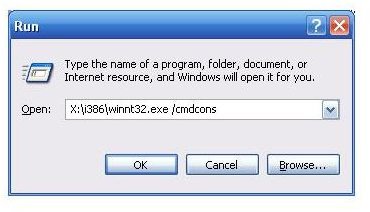
Why use the command line version of Bootcfg? These are the Bootcfg command’s parameters for entry at the Command Prompt. When you see the Welcome to Setup screen, shown in Figure A, press R to start the Recovery Console. Now, simply follow the prompts that will allow the loading of the basic files needed to run Setup.
HOW TO ENTER WINDOWS RECOVERY CONSOLE XP WINDOWS
If it isn’t, find out about using Windows XP Setup Boot Disks here. If the system is capable of booting from the CD, follow the onscreen instructions to do so.

To do so, insert the Windows XP CD and restart the system. Of course, using the Recovery Console version of the Bootcfg command means that you must first launch the Recovery Console. In this situation, you can use the command line version of the Bootcfg command. There are other times when a problem in the Boot.ini file is a subtle one that doesn’t cause major boot problems, but it needs to be fixed nonetheless. When the problem prevents Windows XP from booting up correctly, you’ll use the Recovery Console version of the Bootcfg command. However, that’s not always the best solution sometimes the Boot.ini file can be repaired. Many IT pros think the only solution to this problem is to start from scratch and reinstall the operating system. Often a problem rooted in the Boot.ini file can render Windows XP incapable of booting up correctly. When to use the Recovery Console and the command line As I do, I’ll take a look at both the Recovery Console and the command line versions of the Bootcfg command. In this Daily Drill Down, I’ll explain in detail all of the features and options that the Bootcfg command puts at your disposal. You need to have a solid understanding of how this tool works and when to use it. This command can save you a lot of time and frustration when you need to edit the Boot.ini file. The Bootcfg command is available both as a stand-alone command line tool and as a part of the Recovery Console. Windows XP comes with a new tool designed to make it easier for you to configure and troubleshoot problems with the Boot.ini file. See how Windows XPs Bootcfg command can save you a lot of time and frustration when you need to edit the Boot.ini file. Not only available but gives me the option of booting into the OS on C: or the backup OS which I had already cloned to a separate physical hard drive.Build Your Skills: Get to know Windows XP’s Bootcfg command Submix8c's response (quoted) got me wondering about the already overlayed XP file which I was attempting to burn so ran WINNT32 from there and hit the jackpot, the Recovery Console is now an option in my Boot.ini file. If this works, it'll be faster than Slipstream and a Learning Curve constructing a hand-made CMDCONS.īetween posting and reading your replies I have been trying to slipstream XP/SP2, all seemed to go well but resulting cd is not bootable, more work to be done there with Roxio. Then try running WINNT32 from that folder. Copy the I386 folder from the CD (ALL of it) to your HDD (a new folder preferably) then copy the Service Pack I386 folder (ALL of it) over top of the first overlaying older (original) files ("dirty slipstream"). You should have a Service Pack folder on your HDD (somewhere) containing the I386 SP2 files in it (from an Update).

Just a thought (haven't tried, may not work).


 0 kommentar(er)
0 kommentar(er)
